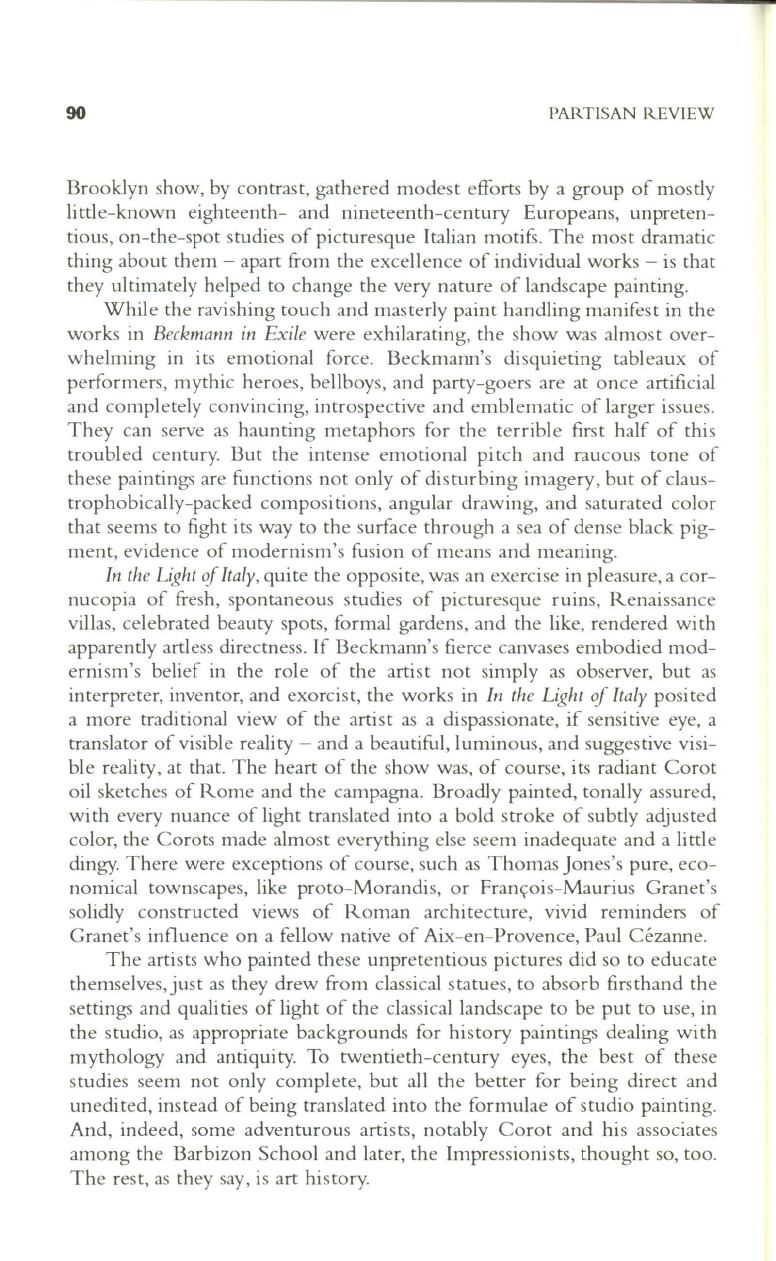
90
PARTISAN REVIEW
Brooklyn show, by contrast, gathered modest efforts by a group of mostly
little-known eighteenth- and nineteenth-century Europeans, unpreten–
tious, on-the-spot studies of picturesque Italian motifs. The most dramatic
thing about them - apart from the excellence of individual works - is that
they ultimately helped to change the very nature of landscape painting.
While the ravishing touch and masterly paint handling manifest in the
works in
Beckmann in Exile
were exhilarating, the show was almost over–
whelming in its emotional force. Beckmann's disquieting tableaux of
performers, mythic heroes, bellboys, and party-goers are at once artificial
and completely convincing, introspective and emblematic of larger issues.
They can serve as haunting metaphors for the terrible first half of this
troubled century. But the intense emotional pitch and raucous tone of
these paintings are functions not only of disturbing imagery, but of claus–
trophobically-packed composi tions, angular drawing, and saturated color
that seems to fight its way to the surface through a sea of dense black pig–
ment, evidence of modernism's fusion of means and meaning.
In the Light
if
Italy,
quite the opposite, was an exercise in pleasure, a cor–
nucopia of fresh, spontaneous studies of picturesque ruins, Renaissance
villas, celebrated beauty spots, formal gardens, and the like, rendered with
apparently artless directness. If Beckmann's fierce canvases embodied mod–
ernism's belief in the role of the artist not simply as observer, but as
interpreter, inventor, and exorcist, the works in
In the Light of Italy
posited
a more traditional view of the artist as a dispassionate, if sensitive eye, a
translator of visible reality - and a beautiful, luminous, and suggestive visi–
ble reality, at that. The heart of the show was, of course, its radiant Corot
oil sketches of Rome and the campagna. Broadly painted, tonally assured,
with every nuance of light translated into a bold stroke of subtly adjusted
color, the Corots made almost everything else seem inadequate and a little
dingy. There were exceptions of course, such as Thomas Jones's pure, eco–
nomical townscapes, like proto-Morandis, or Franyois-Maurius Granet's
solidly constructed views of Roman architecture, vivid reminders of
Granet's influence on a fellow native of Aix-en-Provence, Paul Cezanne.
The artists who painted these unpretentious pictures did so to educate
themselves, just as they drew from classical statues, to absorb firsthand the
settings and qualities of light of the classical landscape to be put to use, in
the studio, as appropriate backgrounds for history paintings dealing with
mythology and antiquity. To twentieth-century eyes, the best of these
studies seem not only complete, but all the better for being direct and
unedited, instead of being translated into the formulae of studio painting.
And, indeed, some adventurous artists, notably Corot and his associates
among the Barbizon School and later, the Impressionists, thought so, too.
The rest, as they say, is art history.


